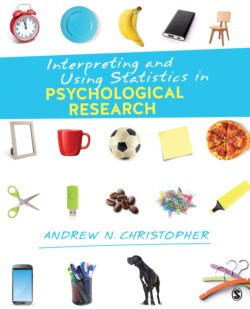Читать книгу Interpreting and Using Statistics in Psychological Research - Andrew N. Christopher - Страница 22
На сайте Литреса книга снята с продажи.
Goal: To Predict
ОглавлениеPredictive research aims to make forecasts about future events. In the case of the weather, if we know the time of year it is, wind flow patterns, and barometric pressure, we can predict the temperature and likelihood of precipitation. Returning to our health-behaviors research, if we have data on college students’ health behaviors, we can use those data to predict outcomes such as grade-point average and satisfaction with college, both of which most colleges are keenly interested in. There are two methods of conducting predictive research. First, using the correlational method, researchers measure the extent to which two or more variables are related to each other (i.e., co-related). In our example, if we know how much sleep a college student gets each night, how many times per week he or she exercises, and his or her daily fruit and vegetable consumption, we can predict, to some extent, outcomes such as GPA and satisfaction with college.
Figure 1.3 What a Positive Correlation Looks Like
We will explore correlational research in more detail in Chapters 12 and 13. For now, understand that there are positive correlations, in which increases (or decreases) in the frequency of one behavior tend to be accompanied by increases (or decreases) in the frequency of a second behavior. To illustrate what a positive correlation looks like, consider Figure 1.3, which displays the nature of the relationship between weekly exercise habits and GPA (Bass, Brown, Laurson, & Coleman, 2013). Each dot on this scatterplot represents one student’s weekly aerobic exercise time (x-axis) and the student’s corresponding GPA (y-axis). In general, as weekly aerobic exercise time increases, GPA increases. This does not happen for every student, but in general, this is the case. Therefore, weekly aerobic exercise and GPA are positively correlated.
Figure 1.4 What a Negative Correlation Looks Like
In addition, the second type of correlation is a negative correlation, which results when increases in the frequency of one behavior tend to be accompanied by decreases in the frequency of a second behavior. To illustrate what a negative correlation looks like, consider Figure 1.4, which displays the hypothetical relationship between weekly alcohol consumption and GPA. In general, as weekly alcohol consumption increases, GPA decreases (Singleton & Wolfson, 2009).
Finally, the third type of correlation is a zero correlation. As you might have guessed, a zero correlation exists when there is no pattern between the frequency of one behavior and the frequency of a second behavior. I am aware of no research that suggests any relationship between physical height and frequency of flossing one’s teeth. I doubt that taller people floss more often than shorter people (which would have been a positive correlation) or that shorter people floss more often than taller people (which would have been a negative correlation).
In addition to the correlational method, predictive research makes use of quasi-experiments. A quasi-experiment compares naturally occurring groups of people. We could compare whether first-years, sophomores, juniors, or seniors have higher GPAs and higher levels of college satisfaction. Here, year-in-school is a quasi-independent variable in the sense that people tend to fall into one of these four types of students. Realize, as with correlational methods, we cannot conclude that being a senior causes students to do better or worse in school (or anything else) than being a first-year. However, such data could still be of interest. For instance, suppose we find the somewhat counterintuitive result that first-years earn higher GPAs and are more satisfied with college than are sophomores. College faculty and administrators would likely want to do more research to understand this relationship (and perhaps do something to facilitate the sophomore experience on their campuses).
Prediction is more powerful than description. Although prediction is never perfect (just think about weather forecasts), it does provide insights into the world around us. Chapters 12 and 13 will provide us with tools that allow us to make predictions from our data.
Predictive research: makes forecasts about future events.
Correlational method: examines how and the extent to which two variables are related to each other.
Positive correlation: increases (or decreases) in one variable tend to be accompanied by increases (or decreases) in a second variable. In other words, the two variables tend to relate in the same direction.
Negative correlation: increases in one variable tend to be accompanied by decreases in a second variable. In other words, the two variables tend to relate in the opposite direction.
Zero correlation: no relationship exists between two variables.
Quasi-experiment: compares naturally existing groups, such as socioeconomic groups.
